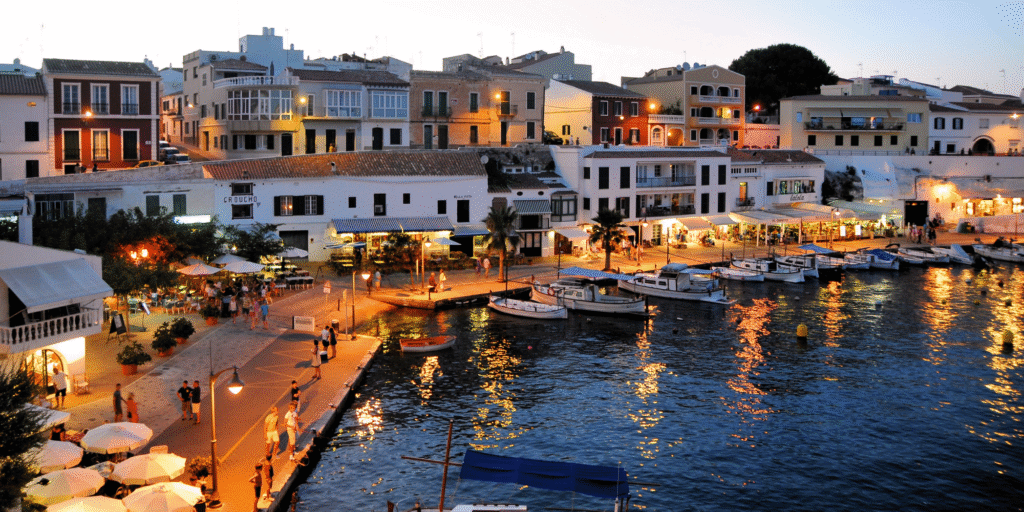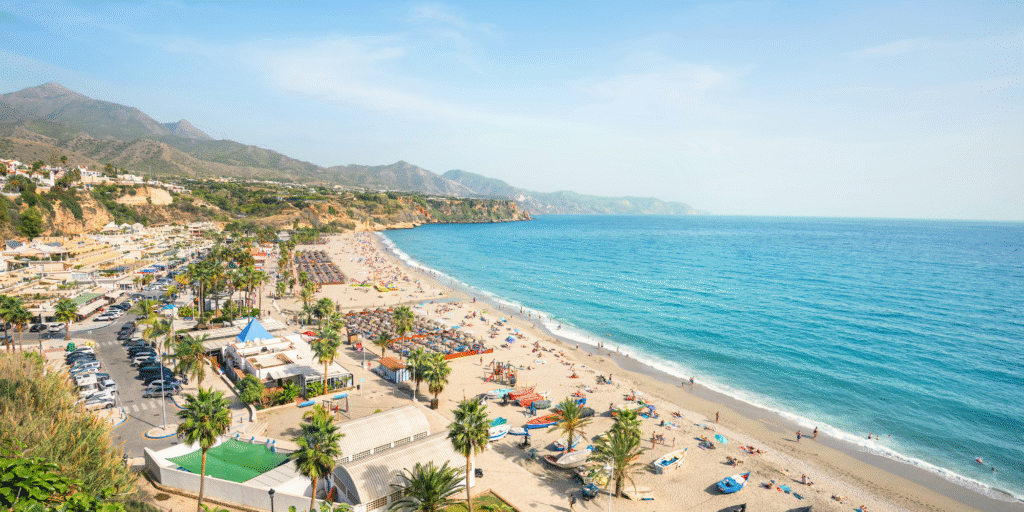Plan your trip with confidence—discover the best time to visit Spain based on weather, festivals, prices, and local tips.
When Is the Best Time to Visit Spain?
Spain is beautiful year-round—but when is the best time to visit Spain for you?
That depends on your goals:
☀️ Sunbathing in the Costa del Sol?
🎉 Dancing through local festivals?
🧭 Exploring without crowds?
🍷 Sipping Rioja in the countryside?
This month-by-month guide breaks it all down—weather, prices, local events, and travel tips—so you can choose the perfect time to say ¡Hola, España!
🔗 Related: Spain Travel Guides by Region | Spanish for Travelers Phrasebook

January in Spain
Weather:
January is winter in Spain. Inland cities like Madrid, Toledo, and Burgos are cold (average 5–10°C), while mountainous regions like the Sierra Nevada can dip below freezing and are covered in snow. The south—especially Andalusia and the Canary Islands—offers milder weather (15–20°C) and plenty of sunshine.
Why visit in January:
- Budget-friendly: January is one of the cheapest months to fly and stay in Spain.
- Post-holiday calm: After New Year’s Day, many tourist areas quiet down, perfect for slow travel and cultural immersion.
- Winter sports: Skiers and snowboarders will love the snow in Sierra Nevada (Granada) and Baqueira-Beret (Pyrenees).
Key Event:
- Día de los Reyes Magos (January 6): Spain’s beloved Three Kings Day is a magical time to witness parades (cabalgatas), gift-giving traditions, and sweet pastries like Roscón de Reyes.
Best destinations:
- Granada: Explore the Alhambra with snow-capped mountains as your backdrop.
- Madrid: Fewer crowds in museums and amazing post-holiday sales in shops.
- Canary Islands: Warm, sunny weather if you’re looking for a winter escape.
February in Spain
Weather:
Still winter, with similar temps to January. However, the days are growing longer, and early almond blossoms begin to bloom in parts of the south. Madrid remains brisk and grey, while Seville and Valencia are slightly warmer.
Why visit in February:
- Less crowded: It’s the perfect time to visit top cultural sites without the long lines.
- Festive spirit: February is Carnival season, and cities like Cádiz and Santa Cruz de Tenerife go all out with parades, music, and dazzling costumes.
Key Event:
- Carnaval (late Feb or early March):
Spain’s version of Mardi Gras is colorful, loud, and lively. Head to Cádiz for satire and music or Tenerife for one of the largest Carnival celebrations in Europe.
Best destinations:
- Cádiz: For a uniquely Spanish take on Carnival.
- Barcelona: Explore Gaudí’s architecture sans the crowds.
- Seville: Enjoy tapas and flamenco in milder weather.
Local tip:
If you’re planning to visit for Carnival, book accommodations early, as cities fill up quickly during this festive period.
March in Spain
Weather:
Spring begins to awaken. The south enjoys pleasant temperatures (17–22°C), while northern regions are still cool and damp. Expect longer days, wildflowers blooming, and the occasional rain shower.

Why visit in March:
- Pre-spring charm: Fewer tourists + warming weather = ideal exploring conditions.
- Seasonal blooms: Almond trees blossom beautifully in Andalusia and the Balearic Islands.
- Festival energy: March kicks off Spain’s festival season.
Key Event:
- Las Fallas (Valencia, March 15–19):
This UNESCO-recognized event fills Valencia with fireworks, music, satire, and enormous paper-mâché sculptures that are burned in massive bonfires on the final night (La Cremà). It’s noisy, unforgettable, and very Spanish.
Best destinations:
- Valencia: Come for Las Fallas, stay for the paella and beach walks.
- Andalusia (Córdoba, Seville): Spring gardens and patios begin to bloom.
- Mallorca: Quieter than summer, with stunning coastal hikes.
Local tip:
Las Fallas is loud and crowded—bring earplugs and book lodging well in advance. If you’re sensitive to noise, stay outside the city center.
April in Spain
Weather:
Spring is in full swing! April brings mild temperatures, averaging 15–22°C across much of the country. Expect blooming landscapes, especially in Andalusia and central Spain. Rain is possible, so pack a light waterproof jacket.
Why visit in April:
- Ideal walking weather—not too hot for sightseeing.
- Semana Santa (Holy Week)—a cultural, religious, and visual spectacle.
- Affordable shoulder-season pricing—especially mid-month.
Key Event:
- Semana Santa (Holy Week):
One of Spain’s most important and moving religious celebrations. Cities like Seville, Málaga, and Granada host solemn processions, with candlelit floats and dramatic music.
Best destinations:
- Seville: The heart of Semana Santa; deeply emotional and atmospheric.
- Granada: See the Alhambra in spring bloom.
- Toledo: Combine history with dramatic Easter parades.
Local tip:
Semana Santa is not a party—it’s deeply respectful. Dress modestly and observe procession etiquette.
May in Spain
Weather:
One of the best months to visit Spain! Weather is warm (20–25°C), the flowers are in full bloom, and it’s still pre-tourist season in many regions.
Why visit in May:
- Stunning gardens & floral events
- Fewer crowds than summer
- Vibrant cultural events in Andalusia
Key Event:
- Patios de Córdoba Festival (first 2 weeks of May):
Private courtyards are opened to the public, exploding with flowers, fountains, and music—a true local tradition.
Best destinations:
- Córdoba: For patios and perfume-like air
- Madrid: Enjoy tapas and rooftop bars under spring skies
- San Sebastián: Mild weather and Michelin-starred meals by the sea
Local tip:
This is the sweet spot for travel—great weather, local life in full swing, and lower prices than peak summer.
June in Spain
Weather:
Summer arrives with sunshine and heat, especially inland (Madrid can reach 30°C). Coasts are cooler and breezy. Long daylight hours make it ideal for outdoor activities.

Why visit in June:
- Beaches without the July crowds
- Major music and fire festivals
- Start of summer vibes, but calmer
Key Event:
- Noche de San Juan (June 23):
Coastal towns celebrate the summer solstice with bonfires on the beach, fireworks, and rituals like jumping over flames or waves.
Best destinations:
- Barcelona or Valencia: For San Juan on the beach
- Galicia: Cooler weather, wild coasts
- Costa Brava: Quiet coves and crystal-clear water
Local tip:
If you’re a beach lover but don’t enjoy crowds, June is better than July or August. You’ll find better accommodation prices too.
July in Spain
Weather:
Hot, dry, and sunny across most of the country. Inland cities can hit 35°C or more. Coastal areas are more manageable with a sea breeze.
Why visit in July:
- Beach life in full swing
- Festival season kicks off
- Long days = more exploring
Key Event:
- San Fermín (Running of the Bulls, Pamplona):
This iconic (and controversial) event features daily bull runs and nightly celebrations from July 6–14.
Best destinations:
- Pamplona: For thrill-seekers and festival-goers
- Balearic Islands (Ibiza, Menorca): Paradise with parties or peace
- Northern Spain (Asturias, Cantabria): Cooler, lush, and off the beaten path
Local tip:
Book everything in advance, especially in coastal or festival areas. Avoid sightseeing in the middle of the day—embrace the siesta lifestyle.
August in Spain
Weather:
Scorching inland (Madrid, Seville often over 40°C), but coastal areas are comfortable. Many locals leave cities and head to the beach.
Why visit in August:
- Beach towns at peak energy
- Iconic festivals and events
- Perfect for sun, sand, and seafood
Key Event:
- La Tomatina (Buñol, last Wednesday of August):
The world-famous tomato fight—messy, fun, and uniquely Spanish.
Best destinations:
- Galicia & Basque Country: Cooler, green, and culturally rich
- Costa del Sol & Costa Blanca: Classic sun-and-sea holidays
- Buñol or Valencia: If you’re brave enough for La Tomatina!
Local tip:
Many small shops in Madrid or Seville close for August, but tourist services stay open. If you hate crowds, this month might not be ideal.
September in Spain
Weather:
Still warm, but more comfortable (25–30°C). Sea temperatures are ideal for swimming. Harvest season begins, and the crowds start thinning.
Why visit in September:
- Perfect balance of good weather + fewer tourists
- Wine festivals and cultural events
- Shoulder-season prices
Key Event:
- Vendimia (wine harvest festivals):
Towns like La Rioja, Jerez, and Ribera del Duero host events with grape-stomping, music, and tastings.
Best destinations:
- La Rioja: For wine lovers and fall colors
- Barcelona: Beach and culture mix
- Granada: Enjoy the Alhambra in peace
Local tip:
September is underrated—you’ll get summer vibes without peak season headaches.
October in Spain
Weather:
Pleasant and crisp, with average temps around 15–25°C. Leaves begin to change in northern regions. Still great for hiking, food tours, and festivals.
Why visit in October:
- Perfect weather for walking tours
- Harvest season continues
- Golden light and fall colors
Key Event:
- Fiesta del Pilar (Zaragoza, Oct 12):
Huge cultural celebration honoring the Virgin of the Pillar. Includes parades, music, food, and traditional dress.
Best destinations:
- Zaragoza: For Fiesta del Pilar
- Basque Country: For fall hikes and food tours
- Madrid: Museum-hopping and rooftop dining in mild weather
Local tip:
Great month for road trips—especially through wine country or the Pyrenees.
November in Spain
Weather:
Cooler and darker, especially in the north. Avg. temps range from 10–18°C. Coastal regions stay a bit warmer, but rain is more common.
Why visit in November:
- Budget-friendly for flights and hotels
- Fall food experiences like mushrooms, chestnuts, and stews
- Cultural trips without crowds
Key Event:
- Día de Todos los Santos (Nov 1):
A quiet and meaningful holiday honoring the dead. Traditional pastries like panellets and huesos de santo are everywhere.
Best destinations:
- Toledo & Salamanca: For history and peaceful walks
- Bilbao: Pintxos and the Guggenheim
- Valencia: Still relatively warm with fewer tourists
Local tip:
Pack layers and skip coastal swimming—but November is ideal for museums, tapas crawls, and hot chocolate.
December in Spain
Weather:
Cool to cold. Inland and northern cities drop to 5–10°C; southern cities and islands hover around 15°C. Cities sparkle with holiday lights.
Why visit in December:
- Festive spirit everywhere
- Christmas markets and nativity displays
- Great off-season deals before NYE
Key Event:
- Navidad (Christmas season):
Spanish Christmas lasts until January 6, with carols, markets, light shows, and sweet treats like turrón and polvorones.
Best destinations:
- Madrid & Barcelona: Christmas lights and markets
- Málaga: Famous for one of the best light shows in Europe
- Granada: Combine holiday vibes with snowy mountain views
Local tip:
Join locals for 12 grapes at midnight on New Year’s Eve—one for each chime, for good luck in the year ahead!
